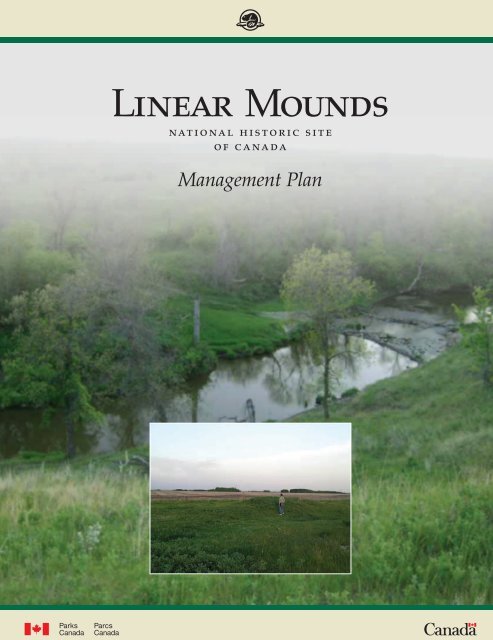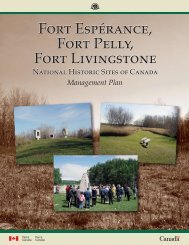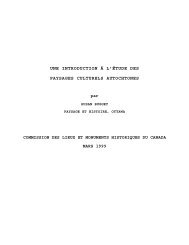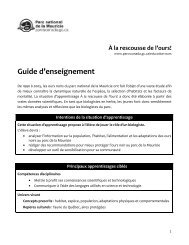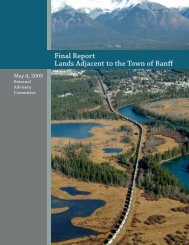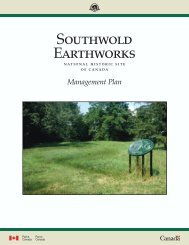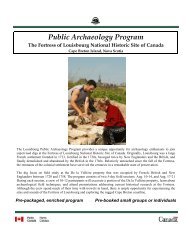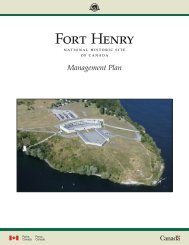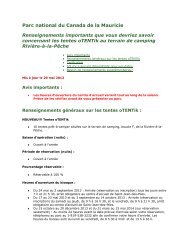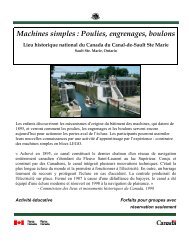Linear Mounds National Historic Site of Canada
Linear Mounds National Historic Site of Canada
Linear Mounds National Historic Site of Canada
You also want an ePaper? Increase the reach of your titles
YUMPU automatically turns print PDFs into web optimized ePapers that Google loves.
linear mounds national historic site <strong>of</strong> canada<br />
Management Plan
Library and Archives <strong>Canada</strong> Cataloguing in Publication<br />
Parks <strong>Canada</strong><br />
<strong>Linear</strong> <strong>Mounds</strong> <strong>National</strong> <strong>Historic</strong> <strong>Site</strong> <strong>of</strong> <strong>Canada</strong> :<br />
management plan / Parks <strong>Canada</strong>.<br />
Text in English and French on inverted pages.<br />
Title on added t.p: Lieu historique national du <strong>Canada</strong> des Monticules-Linéaires :<br />
plan directeur.<br />
ISBN 978-0-662-49890-2<br />
Cat. no.: R64-105/72-2007<br />
1. <strong>Linear</strong> <strong>Mounds</strong> <strong>National</strong> <strong>Historic</strong> <strong>Site</strong> (Man.)--Management. 2. <strong>Historic</strong><br />
sites--<strong>Canada</strong>--Management. 3. <strong>Historic</strong> sites--Manitoba--Management.<br />
4. <strong>National</strong> parks and reserves--<strong>Canada</strong>--Management. 5. <strong>National</strong> parks and<br />
reserves--Manitoba--Management. I. Title. II. Title: Lieu historique national du<br />
<strong>Canada</strong> des Monticules-Linéaires : plan directeur.<br />
FC3364.L57P37 2007 971.27’4 C2007-980057-2E
<strong>Linear</strong> <strong>Mounds</strong><br />
NATIONAL HISTORIC SITE OF CANADA<br />
Management Plan<br />
October 2007
Foreword<br />
<strong>Canada</strong>’s national historic sites, national parks<br />
and national marine conservation areas <strong>of</strong>fer<br />
Canadians from coast-to-coast-to-coast unique<br />
opportunities to experience and understand our<br />
wonderful country. They are places <strong>of</strong> learning,<br />
recreation and fun where Canadians can connect<br />
with our past and appreciate the natural, cultural<br />
and social forces that shaped <strong>Canada</strong>.<br />
From our smallest national park to our most<br />
visited national historic site to our largest national<br />
marine conservation area, each <strong>of</strong> these places<br />
<strong>of</strong>fers Canadians and visitors unique opportunities<br />
to experience <strong>Canada</strong>. These places <strong>of</strong> beauty,<br />
wonder and learning are valued by Canadians<br />
- they are part <strong>of</strong> our past, our present and our<br />
future.<br />
i<br />
Our Government’s goal is to ensure that each <strong>of</strong> these special places is conserved.<br />
We see a future in which these special places will further Canadians’ appreciation,<br />
understanding and enjoyment <strong>of</strong> <strong>Canada</strong>, the economic well-being <strong>of</strong> communities,<br />
and the vitality <strong>of</strong> our society.<br />
Our Government’s vision is to build a culture <strong>of</strong> heritage conservation in <strong>Canada</strong><br />
by <strong>of</strong>fering Canadians exceptional opportunities to experience our natural and<br />
cultural heritage.<br />
These values form the foundation <strong>of</strong> the new management plan for <strong>Linear</strong><br />
<strong>Mounds</strong> <strong>National</strong> <strong>Historic</strong> <strong>Site</strong> <strong>of</strong> <strong>Canada</strong>. I <strong>of</strong>fer my appreciation to the many<br />
thoughtful Canadians who helped to develop this plan, particularly to our dedicated<br />
team from Parks <strong>Canada</strong>, and to all those local organizations and individuals<br />
who have demonstrated their good will, hard work, spirit <strong>of</strong> co-operation and<br />
extraordinary sense <strong>of</strong> stewardship.<br />
In this same spirit <strong>of</strong> partnership and responsibility, I am pleased to approve the<br />
<strong>Linear</strong> <strong>Mounds</strong> <strong>National</strong> <strong>Historic</strong> <strong>Site</strong> <strong>of</strong> <strong>Canada</strong> Management Plan.<br />
John Baird<br />
Minister <strong>of</strong> the Environment<br />
linear mounds national historic site <strong>of</strong> canada<br />
Management Plan
Recommendation Statement<br />
iii<br />
linear mounds national historic site <strong>of</strong> canada<br />
Management Plan<br />
Recommended for approval by:<br />
Alan Latourelle<br />
Chief Executive Officer, Parks <strong>Canada</strong><br />
Dawn Bronson<br />
Field Unit Superintendent, Manitoba<br />
linear mounds national historic site <strong>of</strong> canada<br />
Management Plan
Table <strong>of</strong> Contents<br />
iv<br />
Foreword<br />
i<br />
Recommendation Statement<br />
iii<br />
1. Introduction 1<br />
1.1 <strong>National</strong> <strong>Historic</strong> <strong>Site</strong>s <strong>of</strong> <strong>Canada</strong> 2<br />
1.2 Commemorative Integrity 2<br />
1.3 Management Planning 3<br />
2. Current Situation 3<br />
2.1 Planning Context 3<br />
2.2 Heritage Resources 4<br />
2.3 Heritage Presentation 6<br />
2.4 Visitor Services and Facilities 6<br />
2.5 Administration and Operations 6<br />
2.6 Partnerships and Community Involvement 6<br />
3. Vision 7<br />
4. Management Plan 8<br />
4.1 Resource Protection 8<br />
4.2 Heritage Presentation 8<br />
4.3 Visitor Services and Facilities 8<br />
4.4 <strong>Site</strong> Management and Operations 8<br />
4.5 Partnerships and Community Involvement 9<br />
5. Environmental Assessment Decision Statement 9<br />
6. Management Plan Implementation and Evaluation 10<br />
linear mounds national historic site <strong>of</strong> canada<br />
Management Plan
1<br />
Introduction<br />
<strong>Linear</strong> <strong>Mounds</strong> <strong>National</strong> <strong>Historic</strong> <strong>Site</strong> <strong>of</strong> <strong>Canada</strong> was designated by the Minister<br />
on the recommendation <strong>of</strong> the <strong>Historic</strong> <strong>Site</strong>s and Monuments Board <strong>of</strong> <strong>Canada</strong><br />
(HSMBC), in 1973. These burial mounds lie on the plain above the Antler<br />
River valley in southwest Manitoba. The mounds consist <strong>of</strong> two low earthen<br />
embankments almost 200 metres in length, each terminating in circular mounds.<br />
One feature aligns north-south, while the other lies east-west, and extends beyond<br />
Parks <strong>Canada</strong>’s property into an adjoining field. In addition to the two linear<br />
mounds an elliptical mound also occurs on the site and all three are identified on<br />
the map below.<br />
1<br />
The <strong>Mounds</strong> are attributed to the pre-contact people and are referred to by<br />
archaeologists as belonging to the Devils Lake-Sourisford Burial Complex.<br />
The <strong>Mounds</strong> are broadly dated between AD 900 and 1400 (Syms 1979). Very few<br />
artifacts have been found at <strong>Linear</strong> <strong>Mounds</strong>, however, several artifacts have been<br />
Gravel Entry Road<br />
Parking area<br />
with new<br />
fencing<br />
Top <strong>of</strong><br />
bank<br />
Boundary Commission<br />
Trail sign “Sourisford<br />
Burial <strong>Mounds</strong>”<br />
Antler River<br />
<strong>Linear</strong><br />
<strong>Mounds</strong><br />
Sloped bank<br />
down to river<br />
Triangular boundary <strong>of</strong> Parks<br />
<strong>Canada</strong> Property with a wire<br />
fence down to the river<br />
found at other mound sites in the region. These include; small pottery mortuary<br />
vessels, incised stone tablets and tubular stone pipes. They also include artifacts<br />
fashioned from exotic raw materials such as native copper (probably from Lake<br />
Superior), and marine shell from the Gulf <strong>of</strong> Mexico.<br />
<strong>Linear</strong> <strong>Mounds</strong> is one <strong>of</strong> the best-preserved examples <strong>of</strong> the mound-building<br />
phenomenon in <strong>Canada</strong> and is part <strong>of</strong> the largest mound complex in North America.<br />
linear mounds national historic site <strong>of</strong> canada<br />
Management Plan
2<br />
This is true despite the ravages <strong>of</strong> time, early<br />
relic collectors and many years <strong>of</strong> active farm<br />
cultivation.<br />
Administratively, <strong>Linear</strong> <strong>Mounds</strong> is the<br />
responsibility <strong>of</strong> the Manitoba Field Unit<br />
headquartered in Winnipeg. It is a nonoperational<br />
site having no on-site staff and<br />
no visitor services. As a result there has been<br />
no dedicated operational budget. However,<br />
this status does not diminish Parks <strong>Canada</strong>’s<br />
obligation to protect the site, communicate its<br />
importance and to engage others in achieving<br />
these objectives while respecting the spiritual<br />
nature <strong>of</strong> the site. This management plan<br />
describes the long-term vision for the protection,<br />
presentation and use <strong>of</strong> this important, yet<br />
potentially vulnerable place.<br />
1.1 <strong>National</strong> <strong>Historic</strong> <strong>Site</strong>s <strong>of</strong> <strong>Canada</strong><br />
<strong>Linear</strong> <strong>Mounds</strong> belongs to a nation-wide<br />
network <strong>of</strong> protected heritage areas, which<br />
include <strong>National</strong> Parks, <strong>National</strong> Marine<br />
Conservation Areas and <strong>National</strong> <strong>Historic</strong><br />
<strong>Site</strong>s. 1 <strong>National</strong> Parks and <strong>National</strong> Marine<br />
Conservation Areas are established as<br />
representative examples <strong>of</strong> distinctive land and<br />
marine environments while <strong>Canada</strong>’s <strong>National</strong><br />
<strong>Historic</strong> sites are commemorated because they<br />
represent thousands <strong>of</strong> years <strong>of</strong> human history<br />
and hundreds <strong>of</strong> years <strong>of</strong> nation building. These<br />
special places are part <strong>of</strong> the inheritance <strong>of</strong> all<br />
Canadians and are recognized under law as<br />
being <strong>of</strong> national importance to the history<br />
<strong>of</strong> our country. Parks <strong>Canada</strong> has several very<br />
important roles; both as guardians and as<br />
storytellers for these special places. These roles<br />
are defined in the following objectives for<br />
<strong>National</strong> <strong>Historic</strong> <strong>Site</strong>s: 2<br />
• foster knowledge and appreciation <strong>of</strong><br />
<strong>Canada</strong>’s past through a national program <strong>of</strong><br />
historical commemoration;<br />
• ensure the commemorative integrity <strong>of</strong><br />
national historic sites administered by Parks<br />
<strong>Canada</strong> by protecting and presenting them<br />
for the benefit, education, and enjoyment <strong>of</strong><br />
this and future generations, in a manner that<br />
respects the significant and irreplaceable<br />
legacy represented by these places and their<br />
associated resources;<br />
• encourage and support the protection<br />
and presentation by others <strong>of</strong> places <strong>of</strong><br />
national historic significance that are not<br />
administered by Parks <strong>Canada</strong>.<br />
1.2 Commemorative Integrity<br />
Commemorative Integrity is the corner-stone <strong>of</strong><br />
Parks <strong>Canada</strong>’s Cultural Resource Management<br />
Policy. It is a values-based concept created by<br />
Parks <strong>Canada</strong> to evaluate and manage <strong>National</strong><br />
<strong>Historic</strong> <strong>Site</strong>s. It is used to report to Parliament<br />
and the Canadian public on their condition.<br />
A <strong>National</strong> <strong>Historic</strong> <strong>Site</strong> has commemorative<br />
integrity when:<br />
• the resources directly related to the reasons<br />
for designation as a national historic site are<br />
not impaired or under threat;<br />
• the reasons for designation as a national<br />
historic site are effectively communicated to<br />
the public;<br />
• the site’s heritage values are respected in all<br />
decisions and actions affecting the site.<br />
The values <strong>of</strong> a national historic site that relate<br />
to the reasons for its designation constitute<br />
its commemorative intent. This describes the<br />
specific reason a place has been deemed to be<br />
nationally significant. The commemorative intent<br />
for a national historic site comes directly from<br />
1<br />
154 <strong>of</strong> the more than 900 <strong>National</strong> <strong>Historic</strong> <strong>Site</strong>s are administered by Parks <strong>Canada</strong>. <strong>Linear</strong> <strong>Mounds</strong> NHSC is one <strong>of</strong> them. The remainder<br />
are administered by other federal departments, provinces or territories, or are privately owned.<br />
2<br />
Parks <strong>Canada</strong> <strong>National</strong> <strong>Historic</strong> <strong>Site</strong>s Policy<br />
linear mounds national historic site <strong>of</strong> canada<br />
Management Plan
the recommendations <strong>of</strong> the <strong>Historic</strong> <strong>Site</strong>s and Monuments Board <strong>of</strong> <strong>Canada</strong>, which are approved<br />
by the Minister responsible for Parks <strong>Canada</strong>.<br />
3<br />
1.3 Management Planning<br />
Parks <strong>Canada</strong> has the responsibility, mandated under the Parks <strong>Canada</strong> Agency Act (1998), to ensure<br />
the commemorative integrity <strong>of</strong> national historic sites under its administration. One tool to achieve<br />
this goal is that all national historic sites administered by Parks <strong>Canada</strong> are required to prepare<br />
management plans. Once prepared, management plans are tabled in Parliament by the Minister <strong>of</strong><br />
the Environment and are subject to review every five years.<br />
A management plan constitutes the local expression <strong>of</strong> the general policies <strong>of</strong> Parks <strong>Canada</strong>. This<br />
plan is the first management plan for <strong>Linear</strong> <strong>Mounds</strong> and will meet that requirement. The plan<br />
outlines the long-term direction for the development, operations and management <strong>of</strong> the site. The<br />
goal <strong>of</strong> the management plan is to ensure the commemorative integrity, while guiding appropriate<br />
opportunities for appreciation and enjoyment <strong>of</strong> the national historic site.<br />
Through the course <strong>of</strong> this planning program, Parks <strong>Canada</strong> staff has met with representatives <strong>of</strong><br />
the Canupawakpa Dakota Nation and local municipal representatives, so that we may begin to gain<br />
a better understanding <strong>of</strong> their interests. An ongoing dialogue with these partners and stakeholders<br />
will be central to the implementation <strong>of</strong> this plan.<br />
2<br />
Current Situation<br />
2.1 Planning Context<br />
Saskatchewan<br />
N<br />
0 20km<br />
Hwy 1<br />
Antler River<br />
Hwy 83<br />
Manitoba<br />
Assiniboine<br />
River<br />
Canupawakpa<br />
Dakota Nation<br />
Melita<br />
Oak Lake<br />
USA<br />
Souris River<br />
Whitewater<br />
Lake<br />
<strong>Linear</strong> <strong>Mounds</strong><br />
NHSC<br />
North<br />
Dakota<br />
<strong>Linear</strong> <strong>Mounds</strong> is located in the southwestern corner<br />
<strong>of</strong> Manitoba, approximately 17 km south <strong>of</strong> the town <strong>of</strong><br />
Melita in the Rural Municipality <strong>of</strong> Arthur. Agriculture<br />
is the backbone <strong>of</strong> the regional economy with the<br />
town <strong>of</strong> Melita serving as the key service center to the<br />
surrounding communities. Given its national historic<br />
site status, Melita community leaders have expressed to<br />
Parks <strong>Canada</strong> their desire to develop <strong>Linear</strong> <strong>Mounds</strong> as a<br />
regional tourism destination to boost the local economy.<br />
The closest First Nation community to <strong>Linear</strong> <strong>Mounds</strong> is<br />
Canupawakpa Dakota Nation situated approximately 40<br />
km north <strong>of</strong> Melita. The Canupawakpa Dakota Nation<br />
is dedicated to the preservation and continuation <strong>of</strong><br />
Dakota culture. Community leaders emphasize teaching<br />
children about their culture and great efforts have been<br />
made to retain their language.<br />
<strong>Mounds</strong> associated with The Devils Lake Sourisford Burial Complex are distributed along the fringe<br />
<strong>of</strong> the northern plains. They extend from southeastern North Dakota through southern Manitoba<br />
linear mounds national historic site <strong>of</strong> canada<br />
Management Plan
4<br />
to southeastern Saskatchewan. Leigh Syms 3 has<br />
identified over 200 probable mounds in southern<br />
Manitoba with roughly 70 <strong>of</strong> these mounds<br />
located in the Sourisford area <strong>of</strong> southwestern<br />
Manitoba. The location <strong>of</strong> this burial complex<br />
as well as the nature <strong>of</strong> the recoveries, suggests<br />
the individuals responsible for their construction<br />
were primary bison hunters influenced by<br />
Mississippian expansion during the period <strong>of</strong><br />
AD. 900 - 1400.<br />
<strong>Linear</strong> <strong>Mounds</strong> <strong>National</strong> <strong>Historic</strong> <strong>Site</strong> <strong>of</strong> <strong>Canada</strong><br />
occupies a small triangular portion <strong>of</strong> a quarter<br />
section measuring 16 hectares. The property<br />
was acquired by Parks <strong>Canada</strong> in 1978-9. At<br />
the time <strong>of</strong> the designation, the <strong>Historic</strong> <strong>Site</strong>s<br />
and Monuments Board <strong>of</strong> <strong>Canada</strong> did not state<br />
the reasons for <strong>National</strong> Significance. For the<br />
purposes <strong>of</strong> this planning program, the following<br />
proposed statement <strong>of</strong> commemorative intent<br />
will be used keeping in mind that it may change<br />
depending on the recommendation <strong>of</strong> the<br />
<strong>Historic</strong> <strong>Site</strong>s and Monuments Board <strong>of</strong> <strong>Canada</strong>:<br />
Dakota Nation as well as local municipal<br />
representatives, in order to collaborate on<br />
interpreting the site in a respectful and<br />
appropriate manner.<br />
2.2 Heritage Resources<br />
The main mounds are two low earthen<br />
embankments each almost 200 metres in<br />
length, and terminating in circular mounds at<br />
either end. They are situated on a promontory<br />
overlooking the Antler River. One feature aligns<br />
north south, while the other lies east west,<br />
and extends beyond Parks property into an<br />
adjoining field. An elliptical mound also occurs<br />
on the property. The mounds are scarred by<br />
traces <strong>of</strong> relic hunting, and <strong>of</strong> archaeological<br />
investigations conducted in 1907, 1913 and 1914<br />
The site contains some <strong>of</strong> the best-preserved examples<br />
<strong>of</strong> Aboriginal <strong>Mounds</strong> <strong>of</strong> the Devils Lake-Sourisford<br />
Burial Complex that exist in <strong>Canada</strong>. It was built and<br />
used between AD 900 and 1400.<br />
Parks <strong>Canada</strong> has managed <strong>Linear</strong> <strong>Mounds</strong> as a<br />
land reserve, treating it as a sensitive site, easily<br />
threatened, and <strong>of</strong> sacred significance to First<br />
Nations. In essence <strong>Linear</strong> <strong>Mounds</strong> is a nonoperational<br />
site without visitor services, facilities<br />
or promotion and is monitored on a periodic<br />
basis. This lack <strong>of</strong> development was a conscious<br />
decision intending to minimize the threat <strong>of</strong><br />
artifact theft at this rural and isolated site.<br />
Through the development <strong>of</strong> this management<br />
plan, Parks <strong>Canada</strong> has initiated a working<br />
relationship with the Canupawakpa<br />
Early excavation <strong>of</strong> a mound similar to <strong>Linear</strong> <strong>Mounds</strong> <strong>National</strong><br />
<strong>Historic</strong> <strong>Site</strong> <strong>of</strong> <strong>Canada</strong><br />
by the Royal Ontario Museum and the <strong>National</strong><br />
Museum <strong>of</strong> <strong>Canada</strong>. Recoveries include human<br />
remains and are currently stored at the Royal<br />
Ontario Museum and the Canadian Museum<br />
<strong>of</strong> Civilization. In addition, cultural artifacts<br />
including a number <strong>of</strong> Bison bones are also<br />
included in these repositories. Other material<br />
has been removed by collectors since the mid<br />
1800’s and has been scattered and lost. There<br />
have been no excavations at the site since the<br />
early 1900’s.<br />
3<br />
Leigh Syms is a highly regarded Manitoba Archaeologist who specializes in researching Aboriginal mounds.<br />
linear mounds national historic site <strong>of</strong> canada<br />
Management Plan
5<br />
EXAMPLES OF ARTIFACTS FOUND IN SIMILAR MOUNDS NEAR MELITA<br />
• Miniature pottery vessels with tabs on the rim and<br />
with decorative elements such as deeply incised<br />
spiral grooves encircling the body from base to<br />
neck, incised animals and birds.<br />
Incised spiral pottery vessel<br />
• Incised stone tablets.<br />
Incised stone tablet<br />
• Tubular stone pipes, beads and other objects<br />
fashioned from exotic raw materials<br />
such as catlinite and native copper.<br />
Tubular stone pipes<br />
• Marine shell ornamental collars known as gorgets<br />
from the south Atlantic coast and the Gulf <strong>of</strong><br />
Mexico. On many gorgets appear faces<br />
with a weeping or forked eye motif.<br />
Gorget marine shell<br />
• Bison bones, including crania and carcasses<br />
buried in sub-mound pits.<br />
linear mounds national historic site <strong>of</strong> canada<br />
Management Plan
6<br />
In 1994 reports indicated that cattle grazing on the property were impacting the mounds. Parks<br />
<strong>Canada</strong> initiated a systematic monitoring program to determine if the site had deteriorated. In<br />
2003 and 2004 non-intrusive ground penetrating radar surveys were conducted to enhance our<br />
understanding <strong>of</strong> these burial mounds.<br />
2.3 Heritage Presentation<br />
The degree <strong>of</strong> interpretation and outreach related to this site has been minimal. Parks <strong>Canada</strong><br />
has managed the site as a protected land preserve and has been hesitant to interpret without<br />
understanding the local aboriginal perspective. Interpretation is limited to an exhibit sign installed<br />
on site in 1999 by local community members and messages provided to visitors at the museums in<br />
Melita and Boisevein.<br />
2.4 Visitor Services and Facilities<br />
Because <strong>Linear</strong> <strong>Mounds</strong><br />
is a place <strong>of</strong> burial, Parks<br />
<strong>Canada</strong> has not developed<br />
visitor services or facilities. In<br />
the 1990’s, the municipality<br />
built a road providing easier<br />
access to the site. In 1999,<br />
community representatives<br />
moved the boundary fence <strong>of</strong> Parks <strong>Canada</strong>’s property to create<br />
a parking area. In addition, representatives <strong>of</strong> the community<br />
also installed a wooden kiosk to support the interpretive panel,<br />
(pictured above). Recently, community representatives posted<br />
direction signage, (also pictured above) at all <strong>of</strong> the major<br />
crossroads.<br />
2.5 Administration and Operation<br />
Periodic monitoring is undertaken to assess<br />
disturbance and deterioration<br />
<strong>Linear</strong> <strong>Mounds</strong> is administered by Parks <strong>Canada</strong> under the<br />
<strong>Historic</strong> <strong>Site</strong>s and Monuments Act. The site is managed by the<br />
Manitoba Field Unit <strong>of</strong>fice in Winnipeg and a monitoring strategy<br />
was developed and implemented for the site in 1994. This<br />
includes a visual inspection by walking the entire site as well as a<br />
photographic comparative analysis <strong>of</strong> the mound features using<br />
fixed points <strong>of</strong> reference, to determine if changes are occurring.<br />
Parks <strong>Canada</strong> previously had a small contract with an adjacent<br />
landowner for minor annual maintenance, however, in recent<br />
years this has been discontinued.<br />
2.6 Partnership and Community Involvement<br />
Parks <strong>Canada</strong> recognizes that building partnerships and involving local communities in the<br />
protection and presentation <strong>of</strong> <strong>National</strong> <strong>Historic</strong> <strong>Site</strong>s is the most effective way <strong>of</strong> ensuring that the<br />
linear mounds national historic site <strong>of</strong> canada<br />
Management Plan
sites are cared for and preserved for future generations. In Melita and the surrounding area there<br />
has been interest in promoting and developing tourism at the site. Parks <strong>Canada</strong>’s past decision to<br />
operate the site as a land reserve has frustrated local stakeholders and undermined Parks <strong>Canada</strong>’s<br />
relationship with them.<br />
7<br />
3<br />
Parks <strong>Canada</strong> has initiated discussions with the Canupawakpa Dakota Nation seeking advice<br />
on interpreting the site in a sensitive manner. This planning program will result in Parks <strong>Canada</strong><br />
developing an ongoing dialogue with both local stakeholders and the Canupawakpa Dakota Nation<br />
to achieve the protection and presentation goals <strong>of</strong> this plan.<br />
Vision<br />
This vision describes the long-term direction for <strong>Linear</strong> <strong>Mounds</strong>. It will focus and guide the<br />
planning, management and operation while fostering cooperation among those who will use, enjoy<br />
and care for the site.<br />
• All actions at <strong>Linear</strong> <strong>Mounds</strong> <strong>National</strong> <strong>Historic</strong> <strong>Site</strong> <strong>of</strong> <strong>Canada</strong> respect the relationship that First<br />
Nations have with the site, especially their views concerning its sacred nature.<br />
• The site continues to be a place <strong>of</strong> contemplation, self-discovery, education and reflection<br />
unencumbered by significant infrastructure that would alter its tranquil and natural setting.<br />
• All educational initiatives are developed in partnership with First Nations and stakeholders<br />
to aid the public in understanding and appreciating its significance and its relationship to the<br />
broad and rich heritage in the region.<br />
• Stakeholders are involved in actions, such as the annual monitoring and maintenance program.<br />
Circular terminus at the south end <strong>of</strong> one <strong>of</strong> the <strong>Linear</strong> <strong>Mounds</strong><br />
linear mounds national historic site <strong>of</strong> canada<br />
Management Plan
8<br />
4<br />
Management<br />
Plan<br />
Parks <strong>Canada</strong> will ensure the commemorative<br />
integrity <strong>of</strong> the site by protecting all <strong>of</strong> the<br />
resources <strong>of</strong> <strong>Linear</strong> <strong>Mounds</strong> NHSC, developing<br />
appropriate communication media and ensuring<br />
that all activities respect the special nature <strong>of</strong> the<br />
site.<br />
4.1 Resource Protection<br />
Strategic Goal: The resources that embody the<br />
national historic significance <strong>of</strong> <strong>Linear</strong> <strong>Mounds</strong> are<br />
not threatened or impaired.<br />
Parks <strong>Canada</strong> will collaborate with partners and<br />
stakeholders to identify site values and to ensure<br />
these values are not under threat. This will<br />
involve ensuring that future decisions are based<br />
upon a sufficient level <strong>of</strong> knowledge about the<br />
site.<br />
Actions<br />
• A draft statement <strong>of</strong> commemorative intent<br />
and a definition <strong>of</strong> the designated place will<br />
be developed and submitted to the <strong>Historic</strong><br />
<strong>Site</strong>s and Monuments Board <strong>of</strong> <strong>Canada</strong>.<br />
• Respecting the commemorative intent, a<br />
values statement will be developed with First<br />
Nations and stakeholders describing the<br />
designated place, the reasons for designation<br />
and appropriate means <strong>of</strong> recognition.<br />
• First Nations will be consulted for advice<br />
on the appropriate treatment <strong>of</strong> the cultural<br />
resources.<br />
• A full understanding <strong>of</strong> past archaeological<br />
work and an inventory <strong>of</strong> all resources<br />
removed from the site will be completed.<br />
• An inventory <strong>of</strong> in-situ cultural resources,<br />
including Traditional Knowledge, will be<br />
developed.<br />
• Continue the annual site-monitoring<br />
program.<br />
4.2 Heritage Presentation<br />
Strategic Goal: The reasons for <strong>Linear</strong> <strong>Mounds</strong><br />
NHSC designation as a place <strong>of</strong> national significance<br />
are communicated effectively.<br />
Heritage presentation will be low key and<br />
respectful <strong>of</strong> the spiritual nature <strong>of</strong> the site<br />
as understood by the Canupawakpa Dakota<br />
Nation. This will provide opportunities for<br />
visitors to experience the site in a non-intrusive<br />
manner.<br />
Actions:<br />
• The Canupawakpa Dakota Nation and<br />
local stakeholders will be consulted on the<br />
development <strong>of</strong> appropriate site messages as<br />
well as the means <strong>of</strong> communicating those<br />
messages.<br />
• Parks <strong>Canada</strong> will partner with the local<br />
museums and/or schools to develop modest<br />
<strong>of</strong>f-site interpretation for use by First Nation<br />
and local community members and visitors.<br />
4.3 Visitor Services and Facilities<br />
The site will remain non-operational but the<br />
current facilities developed by local stakeholders<br />
will be adapted to meet both Parks <strong>Canada</strong>’s<br />
requirements and Aboriginal concerns.<br />
Actions:<br />
• Parks <strong>Canada</strong> will work with the<br />
Canupawakpa Dakota Nation and local<br />
stakeholders to develop orientation<br />
information, such as signage, and a website,<br />
while respecting the nature <strong>of</strong> the site.<br />
4.4 <strong>Site</strong> Management and Operations<br />
The site will continue to be administered from<br />
the Field Unit <strong>of</strong>fice in Winnipeg as a nonoperational<br />
<strong>National</strong> <strong>Historic</strong> <strong>Site</strong> under the<br />
<strong>Historic</strong> <strong>Site</strong>s and Monuments Act.<br />
linear mounds national historic site <strong>of</strong> canada<br />
Management Plan
9<br />
Actions:<br />
• Basic site maintenance will be carried out as required.<br />
• Proposed projects and activities at <strong>Linear</strong> <strong>Mounds</strong> NHSC will be assessed as required by<br />
the Canadian Environmental Assessment Act and as directed by the strategic environmental<br />
assessment <strong>of</strong> this management plan.<br />
4.5 Partnerships and Stakeholders’ Involvement<br />
• Strategic Goal: A meaningful and long-term relationship with a local First Nations will contribute to<br />
management decisions for <strong>Linear</strong> <strong>Mounds</strong>. Interested partners, stakeholders and Parks <strong>Canada</strong> will<br />
work together in safeguarding the values <strong>of</strong> the site while presenting site messages to all Canadians.<br />
Parks <strong>Canada</strong> is currently collaborating with the nearby Canupawakpa Dakota Nation to achieve a<br />
long-term mutually beneficial management strategy for <strong>Linear</strong> <strong>Mounds</strong> NHSC. In addition, Parks<br />
<strong>Canada</strong> is consulting with local stakeholders who have an interest in promoting heritage in the<br />
Melita area.<br />
5<br />
Actions:<br />
• Many <strong>of</strong> the actions identified in the above bullets; resource protection, heritage presentation, visitor<br />
services and facilities and site management and operations will provide the opportunity to achieve<br />
this goal.<br />
Environmental Assessment<br />
Decision Statement<br />
As guided by The Cabinet Directive on The Environmental Assessment <strong>of</strong> Policy, Plan and Program<br />
Proposals (2004), a strategic environmental assessment was completed for <strong>Linear</strong> <strong>Mounds</strong> <strong>National</strong><br />
<strong>Historic</strong> <strong>Site</strong> <strong>of</strong> <strong>Canada</strong> Management Plan. Both positive and negative effects were evaluated.<br />
Positive effects included: improved visitor experience, improved heritage presentation and the<br />
creation and fostering <strong>of</strong> relationships with First Nations and local stakeholders. Improved<br />
communication and strong involvement by First Nations and local stakeholders is especially<br />
positive, as there is currently little to no dialogue. The management plan seeks to encourage<br />
participation and then be adaptive, as well as ensure that all parties are involved early in shaping<br />
the future vision for interpretation and protection <strong>of</strong> the site. To this end, a meeting was held on<br />
October 26 and 27, 2006 to initiate dialogue between the Canupawakpa-Dakota First Nation, local<br />
stakeholders, including representatives from the Rural Municipality <strong>of</strong> Arthur and Parks <strong>Canada</strong>.<br />
Some minor negative effects were identified. With the improved heritage presentation and<br />
communiqué, visitor use has the potential to increase. As a result, the current relatively undisturbed<br />
natural state <strong>of</strong> the site may be subject to minor effects including vegetation destruction and<br />
wildlife disturbance. Although it is unlikely that visitor use will elevate to a stage that will result in<br />
linear mounds national historic site <strong>of</strong> canada<br />
Management Plan
10<br />
irreversible negative effects, mitigations have been recommended in the strategic environmental<br />
assessment as to how to minimize these effects.<br />
Some project level environmental assessment as directed by the Canadian Environmental Assessment<br />
Act may be required once the current locally installed facilities are reviewed to ensure they meet<br />
Parks <strong>Canada</strong> operational and environmental standards. At this time there is not sufficient detail to<br />
indicate where those project level assessments may be.<br />
Overall the strategic environmental assessment found that the <strong>Linear</strong> <strong>Mounds</strong> <strong>National</strong> <strong>Historic</strong><br />
<strong>Site</strong> <strong>of</strong> <strong>Canada</strong> Management Plan will have many positive effects that will ultimately result in the<br />
enhancement <strong>of</strong> commemorative integrity. Some minor negative environmental effects may occur.<br />
However taking into account the recommended mitigation stated in the strategic environmental<br />
assessment, no important negative environmental effects will remain.<br />
6<br />
Implementation and Evaluation<br />
This management plan provides long-term strategic direction for managing <strong>Linear</strong> <strong>Mounds</strong><br />
<strong>National</strong> <strong>Historic</strong> <strong>Site</strong> <strong>of</strong> <strong>Canada</strong>. Implementation <strong>of</strong> this management plan is the responsibility <strong>of</strong><br />
the Manitoba Field Unit Superintendent through the annual Field Unit business planning cycle. The<br />
business plan identifies those actions <strong>of</strong> the management plan that will be realized within a fiveyear<br />
period. Any changes to the five-year forecast are captured by the annual review and updating<br />
<strong>of</strong> the business plan. Implementation <strong>of</strong> the strategies and actions may be reconsidered in response<br />
to new circumstances or information, or changing national priorities and decisions.<br />
Progress on management plan implementation will be communicated through annual reporting<br />
and the Parks <strong>Canada</strong> State <strong>of</strong> the Protected Heritage Areas report. The management plan will<br />
also be subject to periodic review (at least every 5 years), and can be amended to reflect changing<br />
circumstances. The public will be consulted about major changes.<br />
linear mounds national historic site <strong>of</strong> canada<br />
Management Plan


